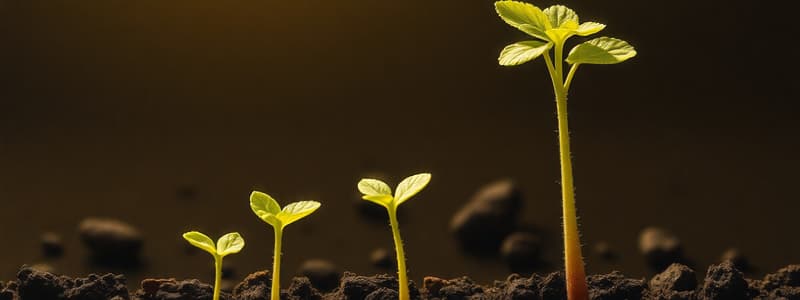Podcast
Questions and Answers
What is the first structure to emerge from a seed during germination?
What is the first structure to emerge from a seed during germination?
- Plumule
- Radicle (correct)
- Epicotyl
- Cotyledon
Which environmental factor is NOT crucial for triggering seed germination?
Which environmental factor is NOT crucial for triggering seed germination?
- Temperature
- Nutrients (correct)
- Water
- Oxygen
During seedling development, what process begins in the leaves for the plant's growth?
During seedling development, what process begins in the leaves for the plant's growth?
- Transpiration
- Germination
- Respiration
- Photosynthesis (correct)
What characterizes the initial growth of a seedling?
What characterizes the initial growth of a seedling?
Which statement about vegetative growth is true?
Which statement about vegetative growth is true?
What marks the transition from vegetative growth to reproductive development?
What marks the transition from vegetative growth to reproductive development?
Which part of the flower expands to form a fruit after fertilization?
Which part of the flower expands to form a fruit after fertilization?
What factor does NOT influence the rate of vegetative growth in plants?
What factor does NOT influence the rate of vegetative growth in plants?
Flashcards
Seed Germination
Seed Germination
The seed develops into a seedling, involving biochemical and physiological changes.
Seedling Development
Seedling Development
Seedling grows into a young plant with root and shoot systems, increasing resilience.
Vegetative Growth
Vegetative Growth
Plant structures like roots and leaves grow larger, increasing the overall biomass.
Reproductive Development
Reproductive Development
Signup and view all the flashcards
Radicle
Radicle
Signup and view all the flashcards
Plumule
Plumule
Signup and view all the flashcards
Photosynthesis
Photosynthesis
Signup and view all the flashcards
Seed Dormancy
Seed Dormancy
Signup and view all the flashcards
Study Notes
Seed Germination
- Germination is the initial stage of plant growth, where a seed develops into a seedling.
- This process involves a series of complex biochemical and physiological changes.
- Environmental factors such as water, oxygen, and temperature play crucial roles in triggering germination.
- The seed absorbs water, leading to swelling and activation of enzymes.
- This triggers the embryo to resume growth and the radicle (embryonic root) emerges first.
- The plumule (embryonic shoot) follows, and the seedling begins to establish itself.
- Seed dormancy, a period where the seed remains inactive, can be broken by environmental cues or internally, preparing the plant for optimal seed germination conditions.
Seedling Development
- After germination, the seedling develops into a young plant.
- The root system grows downwards, anchoring the plant and absorbing water and nutrients.
- The shoot system grows upwards, developing leaves and stems.
- The leaves begin photosynthesis, converting light energy into chemical energy for the plant's growth.
- The seedling's initial growth is characterized by rapid cell division and elongation.
- The seedling becomes increasingly resilient as it develops its structures and adaptations for survival.
- Seedlings are vulnerable at this stage, susceptible to pests and environmental stress.
Vegetative Growth
- This phase involves the continued growth and development of the plant's vegetative structures.
- The plant develops a larger root system to support increased nutrient absorption.
- The shoot system expands with the development of more stems and leaves, increasing the plant's photosynthetic surface area.
- The plant's overall size and biomass increase.
- This growth period often lasts until the plant is ready to reproduce.
- Different plants have varying rates of vegetative growth, influenced by genetics and environmental conditions.
Reproductive Development
- This stage marks the transition to flowering and fruiting.
- Specific hormones trigger the development of flowers, which are the reproductive structures of the plant.
- Pollination occurs, leading to fertilization and the formation of seeds.
- The flower's petals and other parts may wither, detaching from the plant.
- The ovary expands to form a fruit containing seeds, protecting and dispersing them.
- The rate of reproductive development and the size of the crop will often depend on plant and environmental factors.
Harvesting
- This is the final stage of plant growth, involving the collection of mature plants or plant parts.
- Proper timing is crucial for maximizing yield and quality.
- Methods of harvesting vary depending on the type of plant and agricultural practices.
- Mechanical harvesters are used for large-scale production
- Manual methods are sometimes preferred for small-scale or delicate crops for optimal yield.
- Factors such as maturity, crop health, and environmental conditions need to be considered for optimal harvest efficiency.
- Post-harvest management techniques are necessary to maintain quality and extend shelf life of harvested product.
Studying That Suits You
Use AI to generate personalized quizzes and flashcards to suit your learning preferences.




